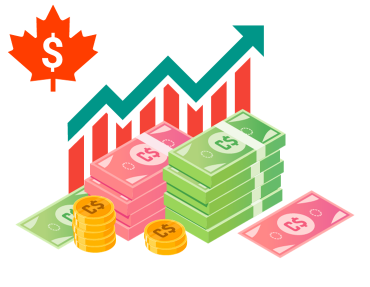In recent years, the Canadian and US economies have become increasingly intertwined, with cross-border trade and investment reaching unprecedented levels. As such, understanding the dynamics of currency exchange rates and trading strategies between these two nations has become essential for investors, businesses, and policymakers alike. In this comprehensive analysis, we will provide readers with a brief overview of the Canadian and US economies, historical trends in currency exchange rates, factors influencing currency valuations, economic indicators to watch when comparing the two currencies, how geopolitical events affect the Canadian and US dollars, trading strategies for investing in CAD/USD, and future outlook predictions for the CAD/USD exchange rate. Through this exploration, we aim to inspire curiosity in readers and provide them with valuable insights into the complex world of international finance.
A Brief Overview of the Canadian and US Economies
The Canadian and US economies are two of the largest in the world and share a close economic relationship due to their geographic proximity. The United States is the largest economy in the world, with a GDP of $21.4 trillion, while Canada is the tenth largest with a GDP of $1.6 trillion. The US economy is driven by a diverse range of industries such as technology, finance, and healthcare, whereas Canada’s economy relies heavily on natural resources such as oil, timber, and minerals. Both economies are highly integrated and have close trading ties due to the North American Free Trade Agreement (NAFTA), which was recently replaced by the United States-Mexico-Canada Agreement (USMCA). In terms of population, the United States has over 328 million people compared to Canada’s 38 million. Additionally, the US dollar is the world’s reserve currency, making it highly sought after by investors around the globe. The Canadian dollar, on the other hand, is considered a commodity currency due to its strong correlation with commodity prices. Overall, while both economies share many similarities, they also have distinct differences that affect their respective currencies and trading strategies.
Historical Trends in Currency Exchange Rates
Historical trends in currency exchange rates between the Canadian and US dollars have been impacted by various factors over time. The CAD/USD exchange rate has experienced fluctuations since the 1970s, with periods of appreciation and depreciation. One of the most significant events that affected the CAD/USD exchange rate was the implementation of a floating exchange rate system in the early 1970s, which led to an increase in volatility. In the 1980s, the Canadian dollar depreciated significantly against the US dollar due to declining oil prices, high inflation rates, and rising debt levels. However, by the mid-1990s, the Canadian economy had recovered, and the CAD/USD exchange rate began to appreciate. The period from 2002 to 2008 saw a strong Canadian dollar, driven by higher commodity prices and a stable economy. The global financial crisis of 2008 caused a sharp depreciation of the Canadian dollar against the US dollar, but it quickly rebounded due to Canada’s strong economic fundamentals. Since then, there have been periods of appreciation and depreciation influenced by factors such as changes in interest rates, oil prices, and geopolitical events. Historical trends in currency exchange rates highlight the importance of monitoring economic indicators to understand how currency values fluctuate over time. Understanding these trends is essential for investors looking to make informed decisions when trading CAD/USD pairs.
Factors Influencing Currency Valuations
There are several factors that can influence the valuation of currencies, including economic indicators, political events, and market sentiment. One of the most important factors is interest rates. Higher interest rates tend to attract foreign investment, increasing demand for the currency and causing its value to rise. In contrast, lower interest rates can lead to a decrease in demand for the currency and a decline in its value. Another key factor is inflation. If a country experiences high levels of inflation, its currency may lose value as it becomes less attractive to foreign investors. Additionally, the balance of trade can also have an impact on currency valuations. A country with a trade surplus (exporting more than it imports) will typically see an increase in demand for its currency, while a country with a trade deficit (importing more than it exports) may experience a decline in demand for its currency. Political events such as elections, changes in government policies or geopolitical tensions can also influence currency valuations by creating uncertainty and causing investors to shift their funds to safer assets. Finally, market sentiment can play a significant role in determining currency values. If investors perceive a particular currency as being strong or weak, they may adjust their trading strategies accordingly, causing the currency’s value to fluctuate. Overall, understanding the various factors that can impact currency valuations is crucial for investors looking to make informed decisions when trading CAD/USD.
Economic Indicators to Watch When Comparing the Two Currencies
When comparing the Canadian and US economies, it is essential to pay attention to several economic indicators that can provide insights into the strength of each currency. One of the most critical factors to consider is the gross domestic product (GDP), which measures the total value of goods and services produced within a country’s borders. A higher GDP typically indicates a stronger economy and can lead to an appreciation of the currency. Another crucial factor is inflation, which refers to the rate at which prices for goods and services are increasing over time. High inflation can erode the value of a currency, while low inflation may signal a robust economy and support currency appreciation. Interest rates are also significant indicators as they affect borrowing costs, investment returns, and exchange rates. When interest rates rise, foreign investors may flock to a country’s currency, increasing demand and boosting its value. Additionally, trade balance data, which measures imports and exports between two countries, can impact currency exchange rates. A trade surplus occurs when a country exports more than it imports, leading to an increase in demand for its currency. On the other hand, a trade deficit can weaken a currency’s value as there is an excess supply of it in the market. By monitoring these economic indicators closely, investors can make informed decisions when trading CAD/USD pairs.
How Geopolitical Events Affect the Canadian and US Dollars
Geopolitical events have a significant impact on the Canadian and US dollars. Political instability, conflicts, and wars can lead to a decrease in demand for a currency, resulting in a decline in its value. For example, tensions between the US and Iran in 2020 caused an increase in oil prices, which negatively affected the Canadian dollar due to Canada’s reliance on oil exports. Similarly, the ongoing trade war between the US and China has caused fluctuations in both currencies due to the uncertainty it creates for businesses and investors. Moreover, changes in government policies and regulations can also affect currency valuations. The election of Joe Biden as the US President in 2020 led to a rise in the Canadian dollar due to his promises of increased economic stimulus and infrastructure spending that could benefit Canada’s economy. Additionally, geopolitical events can affect global market sentiment, which can influence currency exchange rates. For example, the COVID-19 pandemic has caused significant disruptions to economies worldwide, leading to fluctuations in currency values. In conclusion, geopolitical events can have a significant impact on the Canadian and US dollars, and investors should stay informed about political developments to make informed trading decisions.
Trading Strategies for Investing in CAD/USD
When it comes to investing in CAD/USD, there are several trading strategies that investors can consider. One popular strategy is trend trading, which involves analyzing charts and identifying trends in the currency pair’s movements. Investors who use this strategy will look for opportunities to buy when the price is trending upwards and sell when it is trending downwards. Another strategy is range trading, where investors aim to profit from the currency pair’s stability by buying at the lower end of the range and selling at the upper end. This approach requires patience and a keen eye for market patterns. A third strategy is breakout trading, where investors look for significant changes in the CAD/USD exchange rate and take positions based on these movements. This can be a more aggressive strategy, as it involves taking advantage of sudden market shifts. Finally, fundamental analysis can be used to assess the underlying economic conditions that influence the value of the CAD and USD. By keeping an eye on key indicators such as inflation rates, GDP growth, and interest rates, investors can make informed decisions about when to buy or sell CAD/USD. It’s worth noting that no single strategy is foolproof, and investors should carefully consider their risk tolerance and investment goals before deciding which approach to take.
Future Outlook: Predictions for the CAD/USD Exchange Rate
The future outlook for the CAD/USD exchange rate is highly dependent on a number of factors, both domestic and international. One key factor that will impact the Canadian dollar is the country’s economic recovery from the COVID-19 pandemic. As Canada continues to roll out its vaccination program and reopens its economy, this could lead to an increase in demand for the Canadian dollar. Another important factor to consider is the ongoing trade relationship between Canada and the United States. Any changes to trade policies or agreements could have a significant impact on the CAD/USD exchange rate. Additionally, geopolitical events such as political instability, social unrest or natural disasters can cause fluctuations in currency exchange rates. As such, it is important to keep an eye on global developments when considering investing in CAD/USD. In terms of trading strategies, investors may want to consider technical analysis and monitoring economic indicators such as interest rates, inflation and GDP growth rates to make informed decisions about buying or selling CAD/USD. Overall, while predicting the future exchange rate between the Canadian and US dollars is not an exact science, staying informed about economic trends and global events can help investors make informed decisions about their investments.
Understanding the intricacies of the Canadian and US economies and how they impact currency exchange rates is crucial for investors, businesses and policymakers. Through a brief overview of the two economies, historical trends in currency exchange rates, factors influencing currency valuations, economic indicators to watch, geopolitical events affecting the currencies, trading strategies and future outlook predictions, we have gained insight into the complexities of CAD/USD exchange rate. However, there are still many unknowns that may impact the currencies in the coming years, such as changes in political leadership, technological advancements, and global pandemics. It is important to remain vigilant and adaptable in order to navigate the ever-changing landscape of international trade and finance. As we continue to monitor the developments of these economies, it is crucial to reflect on how our actions can influence their trajectories.






Leave a Reply